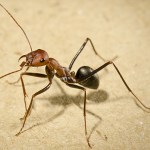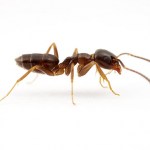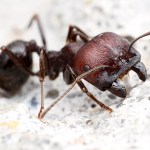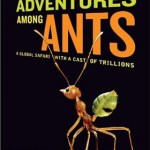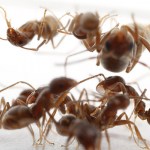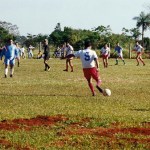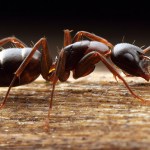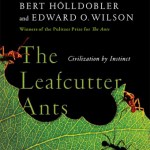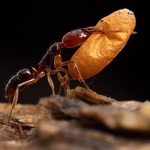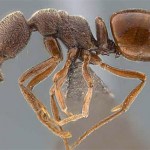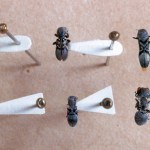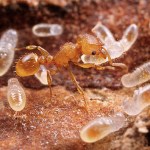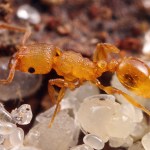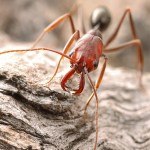ants
I've got this press release that will be of interest to many:
An international team including researchers at the university of Edinburgh and Antoine Wystrach of the Research Centre on Animal Cognition (CNRS/Université Toulouse III—Paul Sabatier) has shown that ants can get their bearings whatever the orientation of their body. Their brains may be smaller than the head of a pin, but ants are excellent navigators that use celestial and terrestrial cues to memorize their paths. To do so, they use several regions of the brain simultaneously, proving once again that the brain of insects is more…
"When you have seen one ant, one bird, one tree, you have not seen them all." -E.O. Wilson
Sure, there are entire worlds within our world that we never even give a second thought to. There's an entire subterranean Universe to explore, and you might get the feeling to do it if you listen to Mecca Bodega's rumbling sound, in
Underground.
But as soon as those tiny critters begin invading your house, the wonder goes right out the window. In fact, you probably haven't thought much about them in terms other than how-to-poison-them in a long time.
Image credit: © 2013 Cool Exotic Pets.
But as a…
The Smithsonian has a cool post on wingless ants that have learned how to glide through the forest canopy using their outstretched legs. If knocked from their treetop nest, Cephalotes atratus avoid falling to the ground by steering themselves, tail first, back toward the tree. Yes, not only can these ants glide, they do it backwards.
Full details over at the Smithsonian Science blog.
A dead ant infected with a parasitic Cordyceps fungus (David P. Hughes).
A team of entomologists working in the Brazilian rain forest has discovered four new species of parasitic Cordyceps fungi, which infect insects and manipulate the behaviour of their hosts in order to disperse their spores as widely as possible.
The modus operandi of Cordyceps is reminiscent of the famous chest-bursting scene in the movie Alien. Microscopic spores infiltrate the host via the spiracles - the holes in the exoskeleton through which insects breathe - and the fungus begins feeding on its non-vital organs.
When…
Tapinoma sessile
Ant ecologist extraordinaire Rob Dunn sends along the following request:
We are looking for live colonies of
Aphaenogaster rudis
Temnothorax curvispinosus or T. longispinosus
Crematogaster lineolata
Tapinoma sessile
from anywhere within their ranges. If you are potentially willing to contribute colonies we would be very grateful. Please contact Sarah Diamond (sediamon@unity.ncsu.edu) regarding details. If you are interested in more extensive collection of colonies, we may be able to reimburse your collection time. These collections will be used to try to understand…
Messor decipiens,
South Africa
Here's a photo I took last week. It shows a granivorous ant with an enormous head housing muscles for milling the harvest. I used Canon's MP-E 65mm 1-5x lens and a twin flash diffused through two sheets of mylar.
The last time I photographed this species was in the field in South Africa, using a little Nikon coolpix digicam. That was in 2003:
While it's true that the greater magnification and sensor quality of the newer and pricier Canon gear make an obvious difference, I'd argue the single biggest advance is in the lighting. The Canon allows my to plug in an…
My review of Mark Moffett's new ant book appears this morning in Myrmecological News:
Let me start with the obvious: Adventures among ants is the most visually stunning ant book ever published.
The physical product, from glossy paper to the tasteful font, is an aesthetic tour de force. The photographs are ... well, this is a Mark Moffett book, and unless you've been hiding under a rock for the past two decades - a reasonable place for a myrmecologist, I suppose - you'll know that Moffett is the National Geographic photographer responsible for much of that magazine's insect imagery from the…
A worker cradles a freshly-laid egg in the brood nest of a laboratory colony of the Argentine Ant Linepithema humile.
photo details: Canon EOS 7D camera
Canon MP-E 65mm 1-5x macro lens
ISO 100, f/13, 1/250sec
Apropos of Paraguay's victory in this morning's world cup match against Slovakia, here's a photo I took almost 15 years ago:
This is a local match in the Paraguayan community where I lived as a Peace Corps volunteer. Our team, from Colonia 11 de Setiembre, beat Ype Jhu 2-1.
But that's not why I'm sharing the picture. Do you see all that dirt mounded up in the foreground? That's a mature nest of Atta sexdens, a leafcutter ant, right on the playing field.
I guess there are two points here. First, ants are an ubiquitous presence in Paraguay, getting into just about everything. It's a…
I haven't posted any ants for awhile. So here is a pair of little carpenter ants from the back yard:
Camponotus nearcticus
Camponotus caryae
Most people in North America think of carpenter ants as the big hairy black things that damage houses by chewing through older and dry-rotted wood. That's certainly true of Camponotus pennsylvanicus, the eastern black carpenter ant.
But the genus contains many smaller and less conspicuous species that nest in pre-formed cavities and plant stems, foraging for scraps and honeydew and generally bothering no one. The two pictured here are both abundant…
Anochetus paripungens trap-jaw ant carrying a cocoon, Australia
photo details:
Canon EOS 50D camera
Canon MP-E 65mm 1-5x macro lens
ISO 100, f/13, 1/250sec
twin flash heads placed in front and behind the subject.
A clip from the documentary "Ants: Nature's Secret Power":
Asphinctopone pilosa Hawkes 2010
The discovery of new insect species continues apace. Today, the online journal Zootaxa presents this pretty little ponerine from Tanzania, described by Peter Hawkes.
Asphinctopone is a rather poorly-known genus previously collected only in the tropical forests of West Africa. Asphinctopone pilosa is larger than the other described species and the first record from East Africa, extending the range of the lineage thousands of kilometers to the east.
source: Hawkes, P.G. 2010. A new species of Asphinctopone (Hymenoptera: Formicidae: Ponerinae) from Tanzania.…
Biologist Henry Hespenheide sends along this shot of several ant-mimicking beetles and their Cephalotes model:
What I take from this image is just how important the appearance of a narrow waist must be to successfully pulling off the illusion. These mimics differ considerably in body proportions, but they have all managed to paint a fake waist on their elytra.
Who was that dashing ant of mystery and intrigue?
Tetramorium simillimum is a small myrmicine that has tramped around the globe with human commerce, quietly inserting itself into native ecosystems. Like most insect species, little is known about its behavior or its interactions with other species.
JasonC gets a clean sweep: ten points for correctly guessing the genus and species.
We haven't done an ant mystery for ages. So here you go:
Although I photographed this little ant in Florida, it could just as easily have been in a number of tropical places.
Five points each for the first person to pick the genus and the species.
The cumulative points winner for the month of May will win either 1) any 8x10 print from my insect photo galleries, or 2) a guest blog post on the (safe-for-work) topic of their choosing.
Bits and pieces of an ongoing project to sequence the genome of the leafcutter ant Atta cephalotes have started going up on Genbank- Have a look!
Of course, these are just raw strings of nucleotides that haven't yet been annotated or analyzed in any meaningful way. The real science won't begin until researchers begin testing hypotheses against the data. But the raw material is there, and this is the first sequence from the ant genome projects to see the light of day. Exciting stuff!
...because badass mandibles are in style this season:
Odontomachus turneri, Australia
photo details:
Canon EOS 50D camera
Canon MP-E 65mm 1-5x macro lens
ISO 100, f/13, 1/250sec
